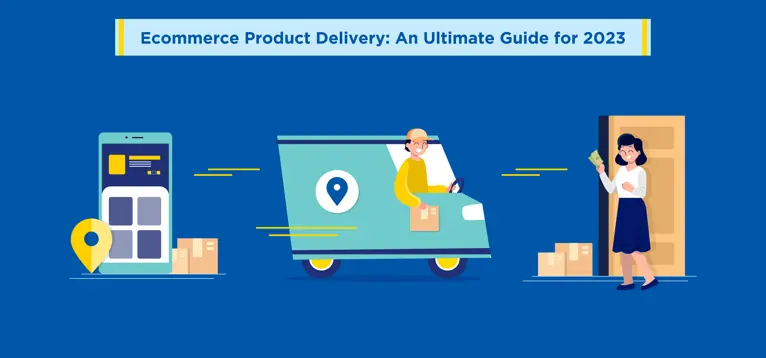Starting an online business may seem like an appealing idea. That is until you get to figuring out how exactly you plan out the logistics and deliver the product to the customer’s doorstep.
An eCommerce product delivery model is more important than many brands realise.
You need to juggle multiple customer expectations like speedy deliveries, affordable shipping, and convenient returns — basically any factor that gives you an edge over the competition.
To satisfy them, you need to have a comprehensive idea of eCommerce product delivery components. What are they?
You’re about to find out.
What is eCommerce Product Delivery?
Ecommerce product delivery encompasses receiving, processing, and delivering orders that customers purchased online. It covers the logistics from the retailer to the customer’s delivery destination.
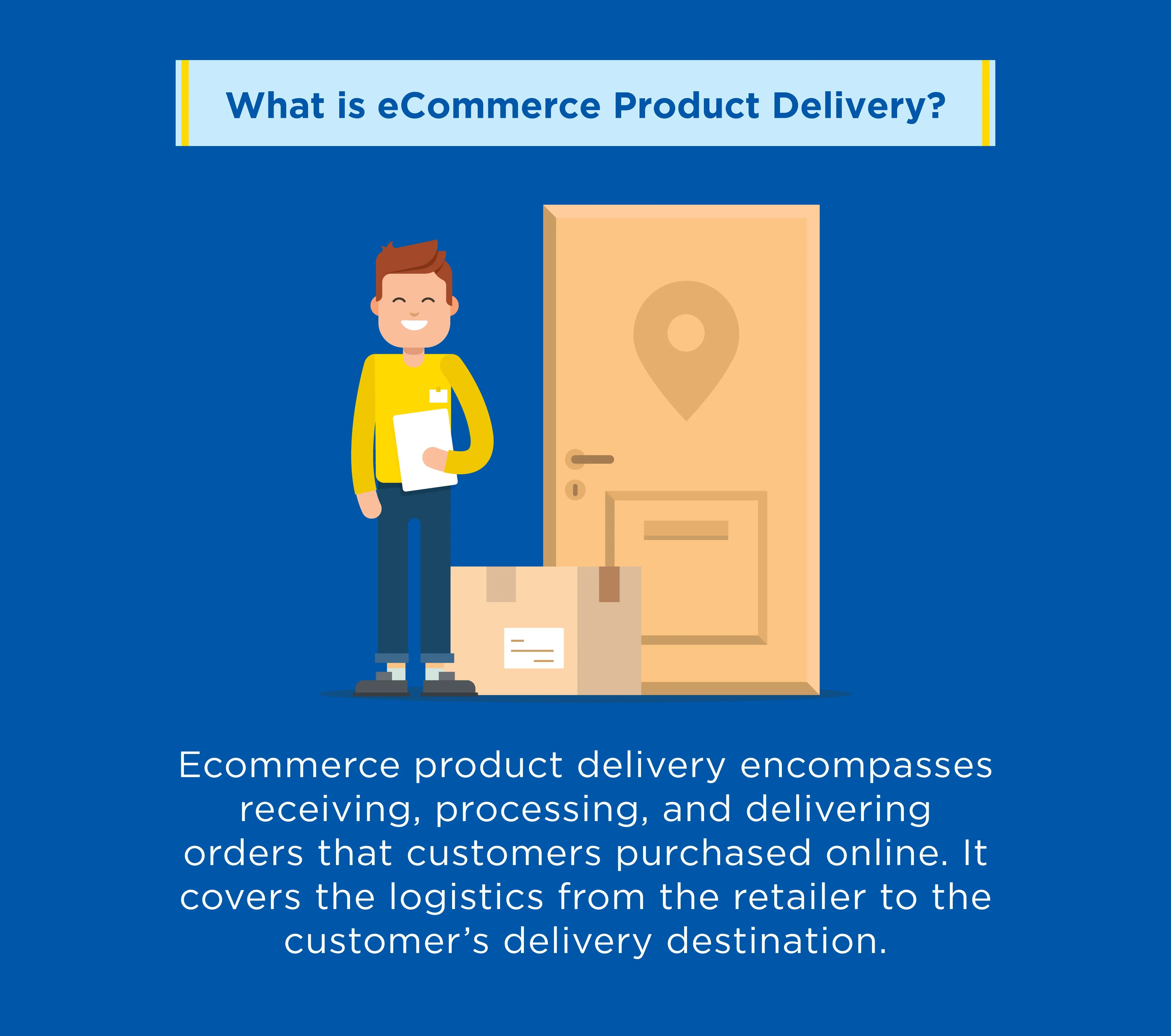
By the definition, it seems a simple process but when online store transactions happen at scale, it increases the level of complexity. You also need to consider transportation methods for different types, and sizes of products you sell, the regions you’ll deliver, shipping speed, etc.
Importance of Order Delivery in eCommerce
Product deliveries define how well of an eCommerce brand you are. It’s what decides when and how your product will reach the customer’s desired destination. An organised delivery workflow makes numerous activities simpler like generating shipping labels, delivery tracking, GST invoicing, order packaging, etc.
The primary function of an eCommerce shipping strategy is to automate the fulfilment process, manage logistics and track and deliver orders in an easier and faster way to meet customer expectations.
And yes, customers do have high expectations when it comes to product deliveries. For example, look at these statistics:
- 51% of customers are willing to pay more if they get faster shipping
- 66% of consumers expect free shipping for online orders
- More than 90% of customers expect orders delivered within a week
This shows that offering a next-day delivery is not just a perk anymore but rather a norm. A seamless order system that quickly processes and delivers orders helps eCommerce brands live up to their reputation.
Some reasons why eCommerce product delivery is more important than ever are:
- Customers today have a lot of choices when it comes to online shopping. Efficient product deliveries can completely change customer attitudes towards your brand.
- Even if you do everything else right, customers will judge you until the last impression you make. So if there’s any issue with your delivery, they’ll likely switch to a competitor.
- It also helps you optimize your supply chain costing and helps you deal with labour shortages, port congestion, and increasing cost of freight and last-mile (final delivery) carriers.
The eCommerce order fulfilment process needs to be top-notch to build an online brand for long-term success. It’s what ultimately sustains brands and helps them navigate through the pool of online stores that we have today.
Ecommerce Product Delivery Process
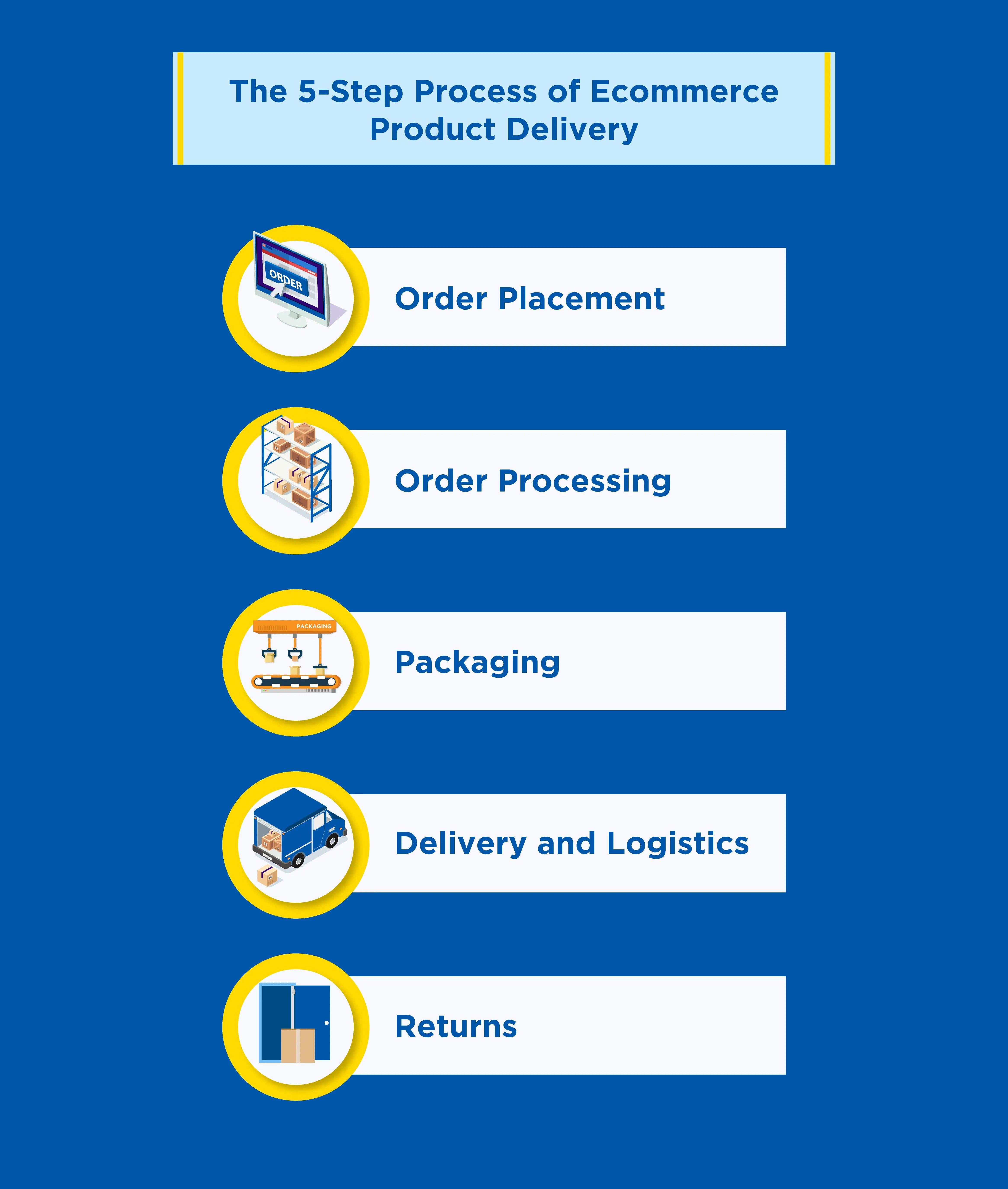
The eCommerce supply chain needs to facilitate the delivery of products across regions, at the fastest speed, and with optimised cost. This happens through five steps which are mentioned below.
Order Placement
Imagine your customers’ buying journey. They browse through the products, add items to the cart, check the pricing, click on ‘Pay’ and voila, you’ve got an order. This is the exact moment when things are set in motion.
Once the order is placed, an order management system sends the order information like product details, shipping time, address, and payment details, from the online store to a fulfilment centre. Each purchase that a customer makes online is associated with a unique order and tracking ID.
Order Processing
Order fulfilment is the process of the customer’s order getting picked and packaged for delivery. eCommerce brands that operate on an international scale have a web of multiple fulfilment centres spread around geographic areas.
The orders are processed through order management systems that determine where to send the orders. This largely depends on the availability of warehouses and end destinations. They also use picking software and hardware that automatically selects the products from the shelves.
Packaging
Order packaging is the final step before the product is out for delivery. Packaging processes ensure that orders are protected, especially if they are fragile or outsized merchandise. They’re stacked with bubble mailers, boxes, and tapes, to ensure they endure the transportation process.
The type of packaging depends on the nature and composition of the item. But brands are becoming increasingly conscious of user-friendly and sustainable packaging. Packaging also includes all the necessary information such as the brand icon, customer name, billing address, details of the items inside, etc.
Delivery and Logistics
eCommerce businesses normally outsource this part of the product delivery process. Logistics companies offer their order fulfilment expertise to deliver the products on time without any hassles.
Online brands are also delivering using micro-fulfilment centres. Micro-fulfilment centres are small-scale warehouse facilities in densely populated urban locations so that customers get timely deliveries. This way, online stores can save costs on large warehouses and fulfil their customers' expectations of immediate delivery.
Returns
Since eCommerce customers have the option to return their purchases, reverse logistics becomes a necessary part of the eCommerce supply chain.
eCommerce return request is processed as soon as the customer places a request on the store. The logistics company has to collect the order from the customer, check the important information like proof of delivery and product conditions, and deliver it back to the warehouse. The refund is collected based on the terms and conditions.
Methods for eCommerce Shipping & Delivery
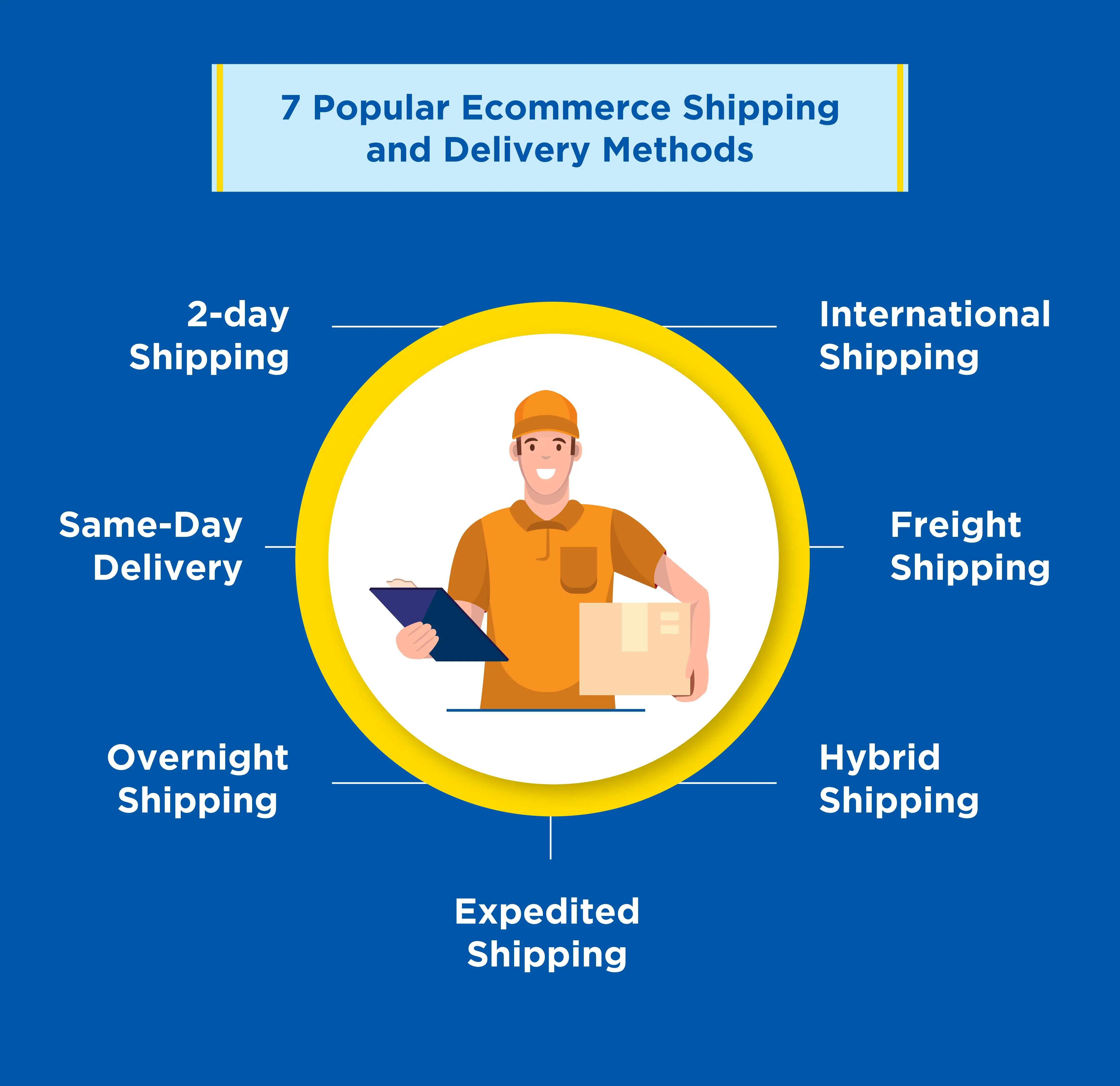
A single shipping strategy cannot fulfil the dynamic requirements of different eCommerce companies. There are numerous methods for shipping and you have to make a decision based on your audience, budget, products, distance, etc.
2-day Shipping
Thanks to online retail giants like Amazon, 2-day shipping has become one of the most sought-after options by customers. It is a delivery method when shoppers receive their orders within two days of purchase. It means two full days or two business days are needed between the order placement and order fulfilment.
Although it may seem feasible for the consumers, there’s a lot that happens behind the scenes. The deliveries are planned and coordinated between ground and air shipping so that the customers receive their orders on time and this is only feasible if you have bulk orders.
Same-Day Delivery
Same-day delivery used to seem like an impossible task. But thanks to technological advances and micro-fulfilment centres that have made it possible for brands to deliver ordered products on the same day. Besides, 88% of the customer are willing to pay a higher amount if they can receive products on the same day.
Same-day or one-day delivery works best for perishable items like food and flowers. If your products are such or even if you commit to customers for same-day delivery, you have fulfilled them at all costs. An ideal tip would be to establish a cut-off time which is the latest time of the day an order can be placed to take responsibility for same-day delivery.
For example, an order placed at 11 pm cannot be shipped on the same day but it's possible for an order that is placed at 10 am. Also, always target zip codes and ship from cities where your customers live. With micro-fulfilment centres and keeping customers in the loop, you can fulfil your commitment to delivering the product on the same day.
If you’re a local business selling to customers in your area, you may have the option to skip shipping altogether and provide your customers with on-demand delivery.
Overnight Shipping
As the name suggests, overnight shipping is when the customer receives their order the next day. This delivery method also works on daily cut-off time for the next-day delivery to be possible.
Also, remember that some carriers and shipping services don’t provide a single-day delivery if the order is placed on weekends. Overnight shipping and delivery require intricately planned logistics networks across regions. Brands can use this method to deliver time-sensitive shipments.
Expedited Shipping
Any type of shipping that is delivered faster than the standard shipping time is called expedited shipping. For example, trucks that are responsible for expedited shipping make few to no stops in between to deliver the goods sooner. This overlaps with the types of shipping we discussed before like same-day delivery or overnight shipping. But the shipping time can depend from carrier to carrier as their shipping standards differ.
International Shipping
Online stores that have global operations have to opt for international shipping services. However, there are other components that make international shipping challenging and expensive. For instance, larger distances mean a higher base charge. You also have to endure the costs of duties, taxes, and fees after considering that different countries have different regulations and tariffs for incoming shipments.
Freight Shipping
Any cargo that is transported via air, land, or sea and is larger than 76 cm x 76 cm x 76 cm (30 inch x 30 inch x 30 inch) or weighs over 68 kgs (150 pounds) is called freight shipping. eCommerce players that deal with scalable operations have to resort to freight shipping to receive inventory from their manufacturers or send products to fulfilment centres and warehouses.
Hybrid Shipping
A hybrid courier simply means there is more than one courier company handling the pick-up, sorting, and delivery of the packages to the end consumers. For example, a courier service provider picks up your order and works with another courier company to transport the goods to a warehouse or a fulfilment centre from where it is shipped to its final destination. eCommerce companies usually opt for this option to cut down on shipping costs.
Things to Consider Before Choosing an eCommerce Delivery Partner
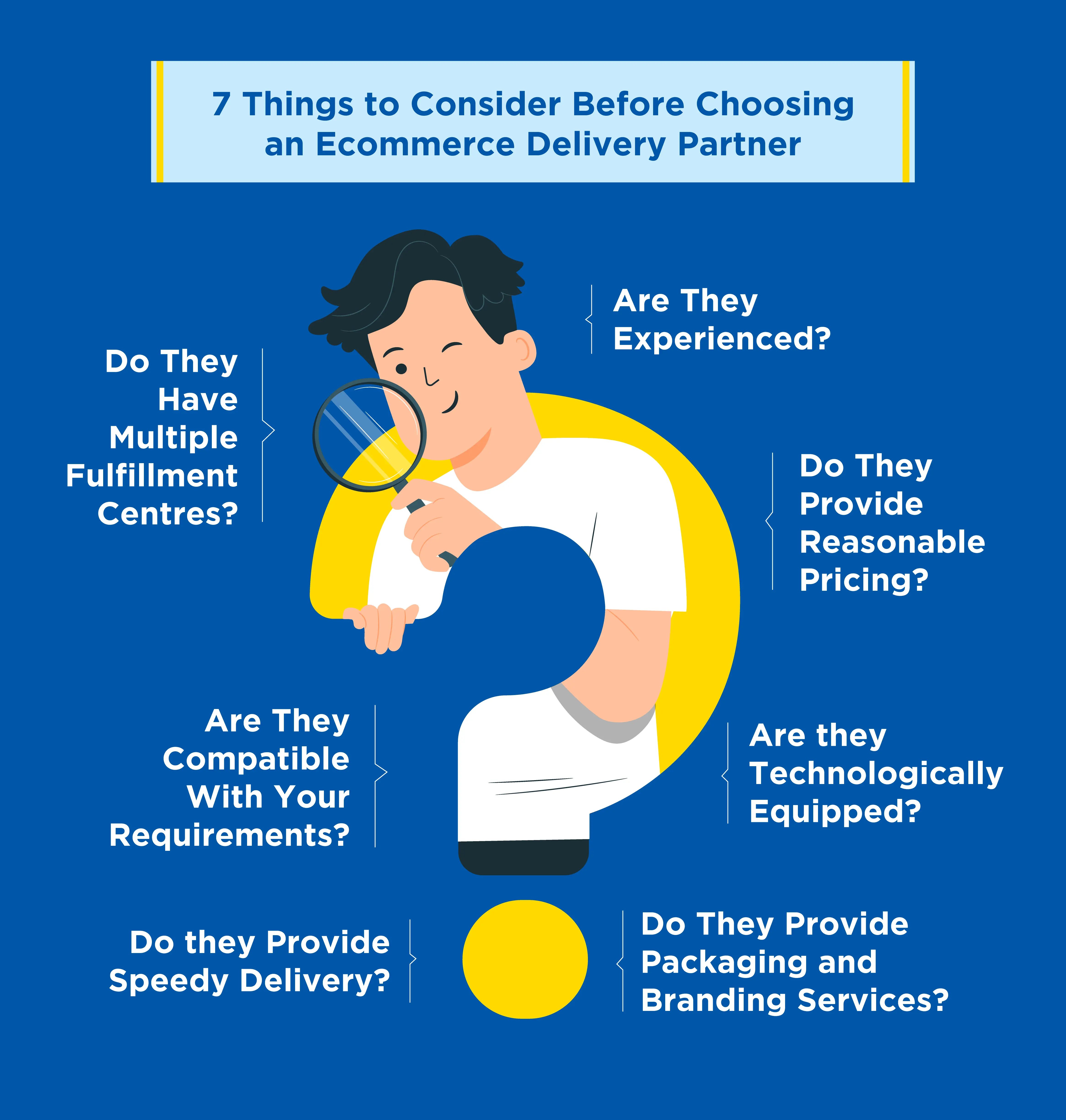
Choosing the right delivery partner is a daunting task. You need to look at numerous possibilities, navigate through the core offerings, and service quality, and check the cost parameters. To choose the right provider, you need to be clear about a few factors before closing the deal.
Are They Experienced?
Logistics is a volatile industry. It is prone to unpredictable circumstances and involves high risk. With so much at stake, you’d want to choose a freight service provider who is experienced and knows how to navigate through the challenges like transporting fragile items and enduring harsh weather conditions.
So do your research on how much the company is experienced. You can check the online reviews and testimonials from previous customers to confirm their work records. For them to fulfil your objectives, the service provider needs to be well-trained, have fulfilment centres at the right places, and be technologically equipped.
If you work with a well-established and reputable company that is competent to handle product deliveries you can be assured of end-client satisfaction.
Are They Compatible With Your Requirements?
The type of shipping services you require will depend on your goals and objectives, and also the type of products you want to deliver. You need to choose a product delivery partner that knows:
- Your business model
- The ideal requirements for shipping your products
- Your brand values, etc.
They need to be in sync with your requirements, the typical amount of orders you will process and the delivery schedule you’ll need for these orders.
If you’re committing a two-day delivery to your customers, your shipping provider needs to have a good track record of making speedy deliveries. Some order fulfilment only specialises in a single activity of the supply chain or only to a particular company size. Gauge their level of expertise and match them with your objectives before finalising a service provider. It’s easy to work with someone who understands your value proposition and the need to meet the expectations of your customers.
Do They Provide Reasonable Pricing?
Sometimes everything can seem right but it all boils down to the pricing and if your budget permits you to go ahead with your desired product delivery partner. Look for a reasonable pricing service provider who helps you save money on labour, and packing supplies, and optimizes delivery routes, and overhead costs.
Even if a good product delivery partner is out of your budget, you can always try negotiating. A low-cost service provider can prove to be significantly beneficial to you. Because they ship large quantities, fulfilment providers can negotiate rates with carriers so that you can save costs.
If you can save costs on shipping, you can even go to the extent of offering discounted or free shipping to your online shoppers.
Do They Have Multiple Fulfillment Centres?
All your customers care about is just wanting speedy and accurate product deliveries. And that is achieved by having fulfilment centres that are close to the delivery locations. The closer the fulfilment centre is, the faster the customer will receive the product.
Once you’re clear as to the geographical boundaries of product delivery, choose partners that cover those areas and are quick with their service. A single fulfilment centre in a metropolitan area cannot suffice the speed requirements and can negatively impact your customer satisfaction.
On the contrary, a network of fulfilment centres and order management systems can ensure quick and uninterrupted delivery services.
Do They Provide Packaging and Branding Services?
Packaging and branding play an important role in brand value and preserving product quality until it reaches the customer. It is the only way that your online brand stands out. Instead of delivering a generic packaged product, branding helps you add the touch of personalisation and draw the attention of the customers, urging them to buy again.
Check if the shipping provider provides options for packaging as well. Does it meet the packaging guidelines? Does it have the infrastructure and expertise to transport temperature-sensitive goods and fragile items? Does it know how to properly label and follow the shipping regulations related to particular products? Only if they do can they avoid product damage and opt for the safest and most cost-effective way to transport your goods.
Do they Provide Speedy Delivery?
You’ve committed a time within which you’ll deliver the product to the customer. And as an online store, this is the least that the customers expect from you. As we discussed before, delivery speed is a decisive factor in online purchases.
Ask yourself, can your delivery partner meet the expectations of same-day delivery or a two-day delivery? This all ultimately draws upon the number of fulfilment centres and their brand reputation.
But check if they have a full-proof plan on how to deliver a product in the shortest time. Do they have the routes optimized? Do they have a tracking system? Do they keep a grace time in case of traffic or a flat tire? Sometimes even the most trivial factors can delay product delivery. Your service provider needs to understand these risks and give a time commitment accordingly.
Are they Technologically Equipped?
For shipping providers to provide exceptional service to you and your customers, they need to be technologically equipped. Technology can automate the most crucial tasks in the product delivery process.
You can automatically send products from your online store to the fulfilment centre and your fulfilment centre can update statuses within the tool itself. They ensure end-to-end visibility of the shipping process to you and to your customers.
Some tools like an order management system, inventory management software and order tracking software are a must for any delivery service provider.
Customers need to have a real-time status of their shipment and so do you. It doesn’t just bring transparency to the delivery process but also helps you make customer-oriented decisions.
Tips to Improve eCommerce Product Delivery
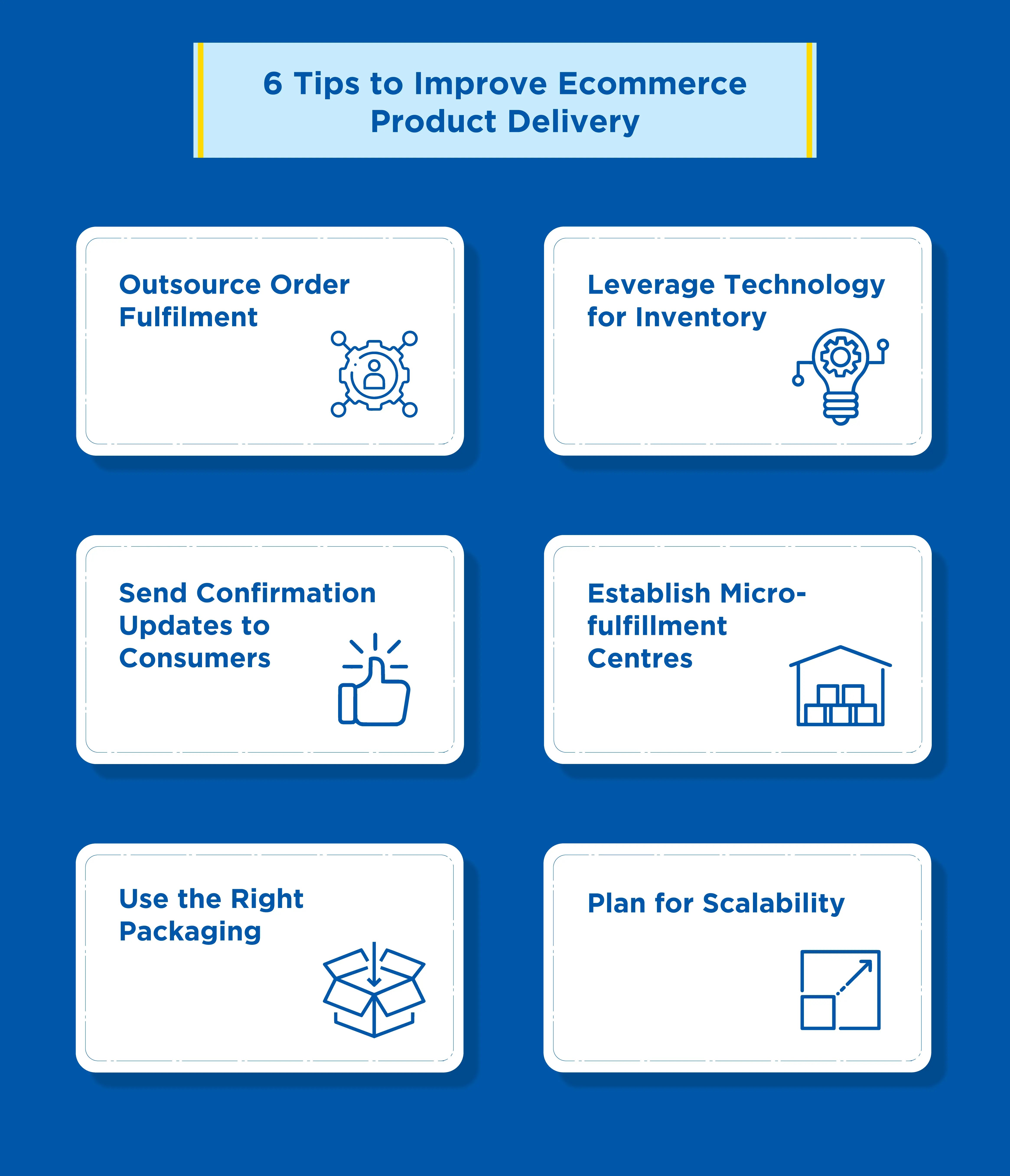
Now you know, a lot of things go into making your product delivery process successful. But let’s face it. It can get quite overwhelming to keep up with trends and the dynamic nature of the logistics industry.
And not every eCommerce company that enters the market has the expertise or the resources to develop a seamless product delivery system. So what do you do in that case?
Outsource Order Fulfilment
Most online stores also don’t have the time and resources to invest in handling the product delivery process. If you delegate these responsibilities to an industry expert, you’ll have the time to do what you’re good at — increase your sales.
You may not realise it when you have a few orders a week that you can easily manage to deliver with an in-house team. But this method is not feasible as you scale.
You need to optimize delivery routes, manage reverse logistics to facilitate product returns, and have the technical and industry knowledge to get everything done in time.
Hence, eCommerce companies outsource these services to a 3PL (third-party logistics) provider that can specifically aid with the backend logistics of eCommerce. It becomes easier when you scale your operations and have to deliver products to longer distances and even internationally.
Leverage Technology for Inventory
To make seamless and fast deliveries, you need to have the right inventory technology at your disposal. Inventory management software allows you to note when customers are placing items in their carts and forecast your demand based on the same.
The tool helps you know how much inventory each fulfilment centre has, what the projected demand for them is based on previous purchases, and how much inventory each fulfilment centre will require by the end of the week or month.
Doing inventory management manually is not only time-consuming but also frustrating since you have to rely on guesses instead of accurate data to predict sales cycles. As an eCommerce store, you’d always want to have enough units to complete sales and avoid surplus in case of lack thereof.
Inventory management tools take into account the rise in demand due to seasonal holidays or natural factors and alert warehouses to stock units.
Send Confirmation Updates to Consumers
Over time, supply chain providers have aimed towards more transparency in the process. And it’s understandable since customers want to stay informed of the delivery status. And even though you provide tracking information to customers, you need to be more proactive in sending them updates about the delivery status.
Many online stores send an automated email and an SMS to the customer every time the product leaves the warehouse, is picked up by the delivery person, and when it’s on its way to the customer’s destination.
It prepares the customer to collect the product instead of catching them at a bad time or delivering when they’re not at their destination. Along with the tracking information, it's viable to add the contact details of the delivery person in the emails and SMS. It makes it easier for customers to reach out in case they want to add delivery instructions.
Establish Micro-fulfillment Centres
It’s simply impossible to make deliveries from far away warehouses across the country. Instead, a small fulfilment centre or even a self-storage unit if you’re a small business, in the middle of the city helps you establish an intricate network of important locations and stay closer to the customer.
For example, if your business is based in Sydney but you need to deliver products in Perth, it’s only ideal to have micro-fulfilment centres in Perth rather than ship a product to Perth every time an order is placed.
Shipping a product from one place to another after an order is placed is also expensive and complex to manage, especially if you’re not paying for shipping services in bulk.
This is another benefit of outsourcing your delivery service since logistics providers have established micro-fulfilment centres in cities.
Use the Right Packaging
How do you define perfect packaging?
There’s no clear answer to this. It always depends on the product you’re selling in your store. Even different types of clothing will have different packaging. For example, a fine-knit jumper can fit perfectly into a jiffy bag but you cannot say the same thing about a chunky-knit sweater.
You need to take clear measures of maintaining product safety during delivery. Imagine the damage your brand will face even if a single customer receives a damaged product.
So select different packaging materials across different product categories. Add layers of bubble wrap for boxed items to offer ultimate protection and pack it with strong parcel tapes to ensure the package is intact throughout the journey.
A well-packed product also says a lot about your eCommerce brand. It shows how sustainable, return-friendly, and brand conscious you are.
Plan for Scalability
When you start your online store operations, a lot of activities may seem doable from your end. But you should know that that’s not how it will always be. As you market your business, your sales will grow and your orders will increase.
Most eCommerce stores fail to realise this shift and ultimately suffer from inefficient operations in the long run. Even if you end up receiving 1000 orders per day which is way above your everyday average, you should not worry about how you’ll meet the delivery requirements.
Planning for scalability also means using a combination of historical data and future predictions and updating these on a regular basis to have accurate predictions. All your decisions should revolve around your growing business and it should reflect in the delivery partner you choose, the software you adopt, and your product delivery strategies.
Choose PACK & SEND for your eCommerce Product Deliveries
Your product delivery process has a direct impact on your customer service and customers’ online buying experience. You need a reliable delivery partner that aligns with your delivery objectives and helps you meet customer expectations.
PACK & SEND is one-stop solution for all your eCommerce delivery needs. With years of experience and extensive abilities, we can you best rates and product delivery options for your online store. So feel free to contact us and allow us set you up for success in your eCommerce product deliveries.
Frequently asked questions
What is eCommerce product delivery?
Ecommerce product delivery encompasses receiving, processing, and delivering orders that customers purchased online. It covers the logistics from the retailer to the customer’s delivery destination.
What are the steps involved in eCommerce product delivery?
There are five main steps involved in the eCommerce product delivery process which are order placement, order processing, packaging, delivery and logistics, and returns. The customer first places the order after which the order is processed to be picked up for delivery. It is then packed safely to avoid damage, and lastly, delivered to the customer. In the same way, return logistics are planned in case the customer places a return request.
What are the methods of eCommerce shipping?
There are seven methods of eCommerce shipping which are:
- 2-day shipping
- Overnight shipping
- Same-day shipping
- Expedited Shipping
- International Shipping
- Freight Shipping
- Hybrid Shipping
How can eCommerce improve delivery?
Outsourcing the eCommerce order fulfilment process is the best way to improve product delivery. Some other steps an online store can take are utilizing technology, planning for scalability, establishing micro-fulfilment centres, using the right packaging, and providing a tracking system to customers.
What is outsourced order fulfilment?
Outsourced order fulfilment means hiring a third party to manage some or all aspects of the product delivery process which can include storing inventory, packaging items, and shipping orders. The third-party logistic provider generally includes all these services required to outsource your fulfilment.
